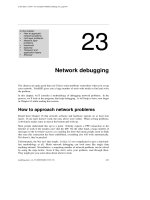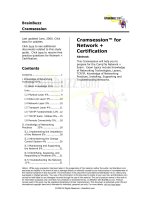Tài liệu Project Management Network Diagram docx
Bạn đang xem bản rút gọn của tài liệu. Xem và tải ngay bản đầy đủ của tài liệu tại đây (811.18 KB, 10 trang )
Project Management
Network Diagram:
A Tool for
Understanding the
PM Life Cycle
1-800-COURSES
www.globalknowledge.com
Expert Reference Series of White Papers
Overview
Fully understanding the Project Management Institute’s (PMI
®
) approach to project management can be diffi-
cult. This is not because of the complexity of the material. The difficulty arises from having a body of knowl-
edge that is structured for referencing, not learning.
PMI divides the tasks associated with project management into 44 processes. There are also 44 different man-
agement activities that must be completed,
in a specific order.
These activities, or processes, are well described by training manuals. Unfortunately they are discussed in isola-
tion from each other. As a consequence it is very hard to develop a comprehensive understanding of the rela-
tionships between the many processes.
If you are new to PMI, you need a summary document that provides an overview and introduction to the big
picture. Once you can see the forest, it is possible to study individual trees.
Fortunately, if you are trying to prepare for the Project Management Professional (PMP
®
) exam, such an
overview is now available through Global Knowledge.
The Project Management Network Diagram (PM Network Diagram) provides a visual illustration of the project
management life cycle (in terms of the chain of events that take place in a project).
Study Time
As a graphical presentation of the project management life cycle this diagram summarizes a large portion of
the Project Management Body of Knowledge (PMBOK
®
). It can radically reduce the time required to prepare
for the PMP exam.
In effect, the PM Network Diagram does for the learning process what a network diagram does for projects. It
provides a visual aid that simplifies the explanation and discussion of project management stages
,
their rela
-
tionships, and their timing.
Time Well Spent
When preparing for an exam,
you will w
ant to make the most efficient use of study time. In order to be effi-
cient, it is necessary to know “what you need to know”.
Brian Denis Egan, Global Knowledge Instructor, MBA, PMP
Project Management Network Diagram:
A Tool for Understanding the PM Life Cycle
Copyright ©2005 Global Knowledge Network, Inc. All rights reserved.
Page 2
T
here are many study guides that review what you need to know in 500 pages. Unfortunately they do not pro-
vide effective overviews or clarify whether every detail needs to be memorized.
The PMP Network Diagram provides the overview that study guides lack. On one 8.5” x 11” page, the PM
Network Diagram summarizes the knowledge needed to answer 50 – 70 percent of questions on the PMP
exam. The diagram provides an overview of what you need to know.
Of course it is still necessary to learn what you need to know, but this is greatly simplified by this roadmap.
Topics Covered
In this white paper you will be introduced to:
• Complications in studying for the PMP
• The PM Network Diagram
• Study tips and techniques
T
his white paper is essential reading if you are considering taking the PMP exam. It will save study time by
clarifying what you need to know.
Background
The PMP Exam is based on the Project Management Body of Knowledge. The PMBOK
®
was created and is
maintained by the Project Management Institute (PMI).
The PMBOK
®
is a compilation of the PMI’s know-how. It is its dictionary of terms and practices. It is a refer-
ence tool for anyone w
anting to lookup a PMI term or procedure
. The PMBOK
®
documents PMI’
s version of
best practices in the field of project management.
The PMBOK
®
is not a study guide
. It is not a training manual.
It is not very pleasant reading. Anyone who has
struggled through the PMBOK
®
deserves a medal.
Complications with Studying for the PMP Exam
The biggest mistake that people make when preparing for the PMP exam is to treat the PMBOK
®
as a training
manual.
T
he PMBOK
®
is not a training manual.
It is a reference tool.
Imagine trying to learn English by reading
a dictionary – pretty tricky. Anyone who “studies” the PMBOK
®
is wasting a lot of time.
Another common error is misinterpreting the nature of the PMP Exam. Is it not a test of project management
knowledge. It is a test of your knowledge of PMI’s terminology.
Seventy years of project management experience will not get you a passing grade on the exam.
The exam does
not test your general knowledge; it tests your specific knowledge of PMI’s version of project management and
its terminology.
The point is that actual project management experience might even work against you. For example, if you do
not use the term
“scope definition” in the same way as PMI, you are going to give incorrect answers. You
must know its terms and use them its way.
Copyright ©2005 Global Knowledge Network, Inc. All rights reserved.
Page 3
I
n order to pass the exam you need to know how to think like the PMI.
What Is in a Word
In order to understand PMI terminology you must understand how the PMI breaks up a project into separate
activities, or processes, and how these processes interrelate.
There are 44 processes. Each one relates to a variety of others. You need to know what the various relation-
ships are. Learning these relationships is not easy--not because they are particularly complicated, but because
of the way the relationships are explained. (More on this later.)
A Moving Target
The 2000 PMBOK
®
(version 2) had only 39 processes (activities necessary to complete a project). The 2004
PMBOK
®
(version 3) has 44 processes
. This means that the PMI has changed its terminology. It has rearranged,
renamed and added processes (activities) to reflect an evolving vision of best practices in the field of project
management. In so doing they have changed the vocabulary of project management.
If you are perfectly familiar with the terminology used in version 2 of the PMBOK
®
you could not pass the new
PMP exam, which is based on version 3 of the PMBOK
®
. Why? Because you do not know the new terminology.
Vocabulary is what the PMP exam is testing.
Training Manuals
There is a big weakness in the way PMP Exam prep training manuals are structured. Of the seven that I have
reviewed, all mimic the structure of the PMBOK.
In other words, they attempt to teach you how to write in
English by reviewing the contents of an English dictionary, step-by-step.
Figure 1 (on the next page) is from the 2004 PMBOK
®
. This figure is central to understanding PMI terminology
.
It relates the 44 processes (activities) to Project Phase and Knowledge Areas by putting them into columns and
rows respectively
.
Copyright ©2005 Global Knowledge Network, Inc. All rights reserved.
Page 4
Figure 1: Chart of Process Groups and Knowledge Areas (2004 PMBOK
®
)
How, you might ask, does this chart aid in understanding? That is a good question!
Like the rest of the PMBOK
®
, the figure above merely lists the processes. It is not a useful study guide or train-
ing tool.
PMBOK Structure
What the table does do is explain how the PMBOK
®
, and related PMP training manuals, are structured. They
follow the pattern set out in the table
.
The PMBOK
®
and training manuals discuss processes by row (knowledge area) rather than by column (phase).
The explanations of processes, therefore, are not given in chronological order.
Let’s continue with the dictionary analogy. In the PMBOK
®
, the first letter of the alphabet is not “A” but
“Project Integration Management”.
T
his is the first knowledge area and is the first row in figure 1.
T
he second
letter in the PMBOK
®
alphabet is not
“B” but “Project Scope Management”, and so on down the left hand
column.
Copyright ©2005 Global Knowledge Network, Inc. All rights reserved.
Page 5
Contract
Closure
Contract
Administration
Request Seller
Responses
Select Seller
Plan Purch ases an d
Acquisitions
Plan Contracting
12. Project Procurement
Management
Risk Monitoring
and Control
Ris k Management Planning
Ris k Identificat ion
Qualitative Risk Analysis
Quantitativ e Ris k Analysis
Ris k Response Planning
Project Risk
Management
Performanc e
Reporting
Manage
Stakeholders
Inform ation
Distribution
Communications Planning
Project Communic ations
Mana gement
Manage Project
T
e
am
Acquire Proje ct
T
e
am
Develop Project
Team
Human Resource Planning
Project HR Management
Perform Quality
Control
Perform Quality
Assu rance
Quality Planning
Project Quality
M
a
na ge
m
ent
Co
s
t C
o
n
t
rolCo
s
t E
s
ti
m
a
t
i
ng
Cost Bu dgeting
Project Cost
Mana gement
Sch edule Con trol
Activity Definition
Activity Sequencing
Activity Resource Estimating
Activity Duration Estimating
Schedule Developm ent
Project Time
Mana gement
S
c
o p
e
Veri
f
i
ca
t
i
o
n
Sco pe Control
S
c
op
e
P
l
an
nin
g
Scope Definition
Create WBS
Project Scope
Mana gement
Close
Project
Monitor and
Control Work
Integrated Change
Control
Direct and
Manage
Proje ct
Execution
Develop Pr oject Management
Plan
Develop Pro ject
Charter
Develop Preliminary
Project Scope
Projec
t
Int
e
gration
M
a
na ge
m
ent
CloseControllingExecutingPlanningInitiating









